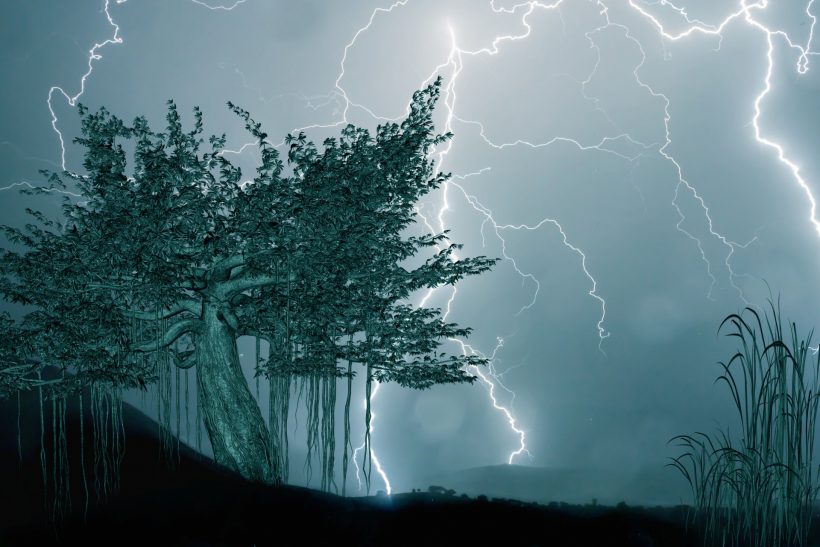LIGHTNING SAFETY WEEK – June 21-27
St. Elmo’s fire was apparently named for St. Erasmus of Formia the patron saint of sailors. This phenomenon sometimes appeared on ships at sea during thunderstorms and was regarded by sailors with religious awe for its bright blue or violet glowing ball of light. Sailors may have considered St. Elmo’s fire as a good omen being the sign of the presence of their patron saint.
My only experience with St. Elmo’s fire occurred years ago during a lightning storm while we were sheltered, or so we thought, in our small cabin. As often is the case the lightning strike was a bolt out of the blue and as the hair on our bodies literally stood up we saw this ball of blue light enter at one end of the building and travell in a straight line to a pole lamp, lighting it up momentarily before exiting. We didn’t have time to blink let alone assume the fetal position as is sometimes advised to minimize the target.
As the storm raged my excited wife encouraged me to take down the old TV tower left by a previous occupant. Advice, I hasten to add, I didn’t follow.
Following are two announcements published many years ago in The Bancroft Times that illustrate the seriousness of lightning.
LIGHTNING KILLS MAN NEAR WOOLER
Police Constable Allan Ormshaw was killed by a flash of lightning during a fierce electrical storm that broke over Trenton late Monday afternoon.
The constable was off duty and had been working on a house he was building on the Wooler Road, about three miles north of Trenton.
After the storm broke he set out to seek shelter at the neighbouring residence of his father-in-law. When he didn’t turn up after the storm was over members of his family became alarmed and went to find him. They discovered his body in a field. His head had been badly burned and his clothes were torn off by the force of the bolt. He leaves his wife and a son.
TEAM OF HORSES KILLED BY LIGHTNING
A team of horses hitched to a wagon and driven by Andrew Wilson of Fort Stewart, were killed instantly last Friday evening by a bolt of lightning during a thunderstorm which passed over that area. Mr. Wilson sustained a severe shock when thrown from the wagon. It was a narrow escape for Mr. Wilson and an experience which he will not soon forget.
On a personal note, I recall my parents discussing a couple whose wedding they had attended. The newlyweds went golfing during their honeymoon. A lightning storm struck, they sought shelter under a tree and an electrical bolt hit nearby. The electrical energy travelled down the tree trunk, through the roots underground causing a strong shock and killed them both.
While guiding on Lady Evelyn, paddling into our base camp, I watched three anvil clouds circling on the horizon no doubt raising havoc. Within their described circumference it had the sounds and appearance of the booming guns of war. Keeping my eye on the sky we were prepared to go ashore instantly if they started to head our way. As it turned out we just managed to make our destination and had nicely begun to settle in when the storm hit with all of its dramatic fury.

“WHEN THUNDER ROARS, GO INDOORS!”
Thunder is the noise created when air suddenly expands from the heat of a lightning discharge. Lightning is an electrical discharge caused by the build up of static electricity between thunderclouds and the ground or clouds. It can deliver as much as 100 million volts of electricity and strike a target up to 16 kilometres away. The farthest horizontal distance that a flash has travelled was recorded at 200 miles (321 km).
It takes 5 seconds for sound to travel one mile or 1.6 km. If you count the seconds between a flash of lightning and a thunder clap, you can tell approximately how close the lightning is to you. Each second represents about 300 metres. Think of the metric mile as a base measurement. You are considered to be in the high danger zone if you are less than 10 kilometres away. If you can hear thunder you are within striking distance. If you have to seek shelter from a lightning storm do not resume any outdoor activity for at least 30 minutes after hearing the last clap of thunder.
Lightning Safety Awareness Week will be featured from June 21 to 27, 2021 the same as in the U.S. It used to be earlier in Canada but was changed for greater public awareness. Much of this information has been gleaned from the Canadian Lightning Detection Network, Environment and Climate Change Canada (ECCC) and the Canadian Safety Council. The activity-related information is derived strictly from the analysis of media accounts, not healthcare data. The media reports captured about 90% of fatalities that are noted in the government’s vital statistics and 10% of the total injuries were estimated from the government healthcare stats.
The majority of lightning-related fatalities and injuries occur in southern Ontario, June to August, with July being the busiest month. More daily injuries, 50% of which take place in the afternoon, occur during the weekend as versus the weekday. The majority of lightning fatalities involve males aged 18-54, mostly under 45, and one source reported that the male fatalities are as high as 78%; 15% are female, ages 18-54. As for injuries 63% are male, 37% female. Apparently men are less likely to take evasive action early. Outdoor recreation accounts for 58% of the fatalities, 50% for those injured. 92% of those killed were either in open areas or sheltered by trees; 20% specifically seeking shelter under a tree or under an open gazebo. 35% of people injured were under or near a tree. 87% of the victims were outdoors when affected. Definite numbers for fatalities are hard to come by for two major reasons.
- Fatalities are often classified in hospitals as heart stoppage or electrocution, not as lightning strikes.
- The statistics that the Canada Safety Council has are compiled by ECCC and are only released sporadically.
“A building is a much safer and drier option,” wrote Lyn Mainwaring of the Canadian Lightning Detection Network.
Soccer and baseball account for 38% of the outdoor sports most commonly affected by lightning. Campers, hikers, golfers, picnickers and boaters were also commonly affected. By the way, during the summertime lightning flashes occur every 3 seconds. Southern Ontario has the most lightning flashes in Canada. Perhaps due to its large coverage area Chatham-Kent suffered the most lightning strikes from 1993-2013 (the most up-to-date stats) followed by Windsor, London, Sarnia, Stratford, Hamilton, then Mississauga and Toronto which were tied. Almost half of all injuries occurred to people in Ontario. New Brunswick, Alberta and Quebec each accounted for 10-15% of lightning incidents. In western Canada lightning causes about half of all forest fires.

Here’s how a lightning strike can kill or injure. A strike hits a tree or pole and the current disperses through the ground. A lightning strike that hits the ground can travel 10 metres although people have been injured 15-30 metres away. Ground currents are responsible for 40-50% of the injuries or deaths, side flashes 20-30%, contact such as via a fence or tree 15-25%, and direct strikes 3-5%. For more illustrative information goto: https://www.canada.ca/en/environment-climate-change/services/lightning/safety/dangers.html.
SOME DOs AND DON’Ts
DO
- Stay clear of high ground and open spaces.
- Seek shelter in a house, large building or motor vehicle. Keep windows and doors shut.
- Riding a bicycle, motorcycle or ATV? Get off! The rubber tires will not protect you.
- If boating, head for shore. If caught on the water crouch low in the boat.
- If you are in a flat, open field, bend down and put hands on knees. Maintain minimum contact with the ground.
- Stay away from water, lakes and puddles.
- Stay sheltered until the storm passes.
DON’T
- Don’t seek shelter in a shed, under a tree or a small open building.
- Don’t lie down on the ground.
- Don’t take a shower or a bath. If lightning strikes the plumbing system it can be conducted into the shower or tub.
- Don’t use the landline phone or an electrical appliance.
- Don’t travel in a severe storm. If caught in your car pull off the road, park away from power lines and keep your windows closed. This creates the Faraday cage which allows the lightning charge to flash over the vehicle and be discharged into the ground. The tires do not provide insulation from lightning and may in fact explode.
- Don’t try to finish your activity. Postpone the inning or round of golf until the storm has completely passed.
Bottom line
Plan ahead. Know when storms normally develop, watch for their development and check the weather reports. Plan to be in a safe place before the storm strikes. Stop what you are doing and seek safe shelter.
Always remember, when thunder roars, GO INDOORS!
Photos – 1. Public domain 2. Public domain 3. Wikimedia – cloud to cloud lightning.
.
